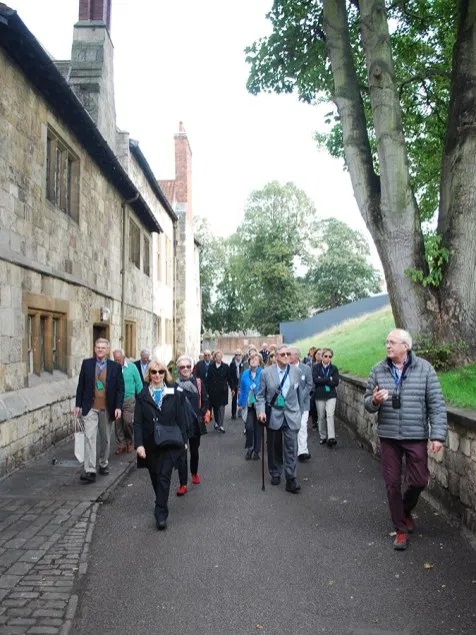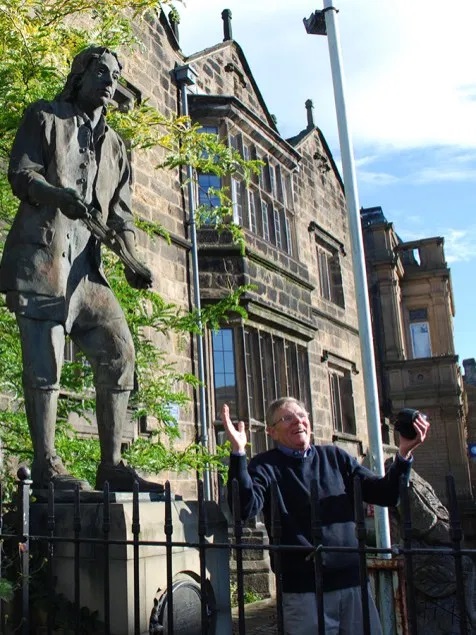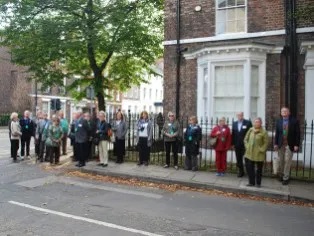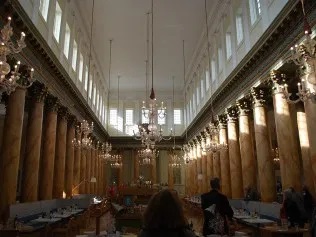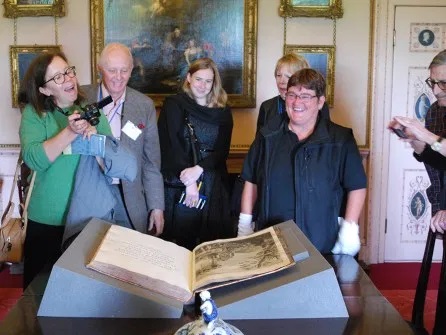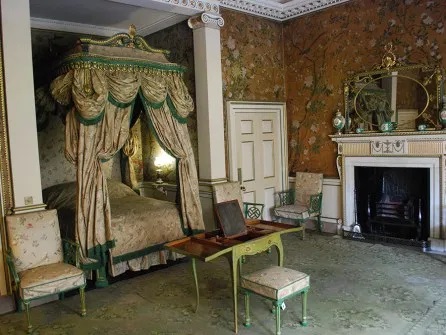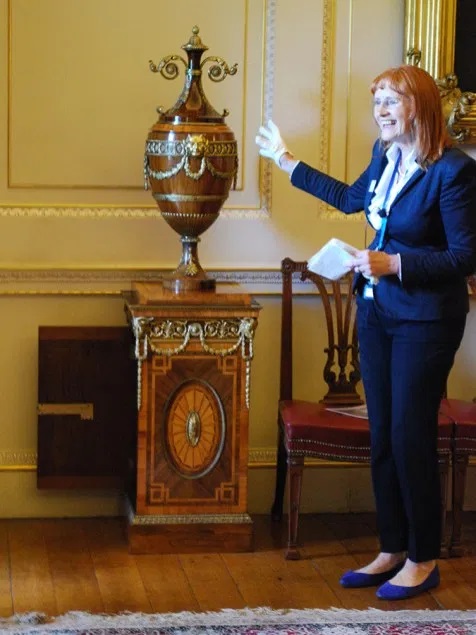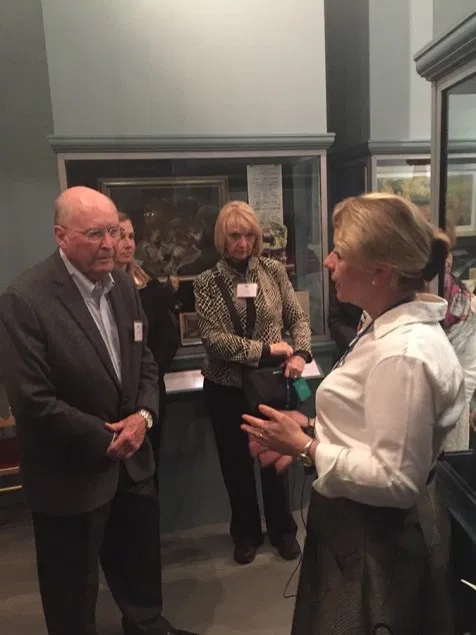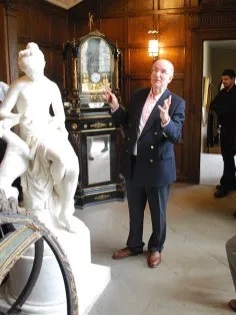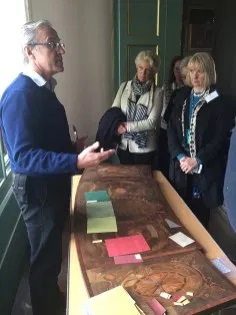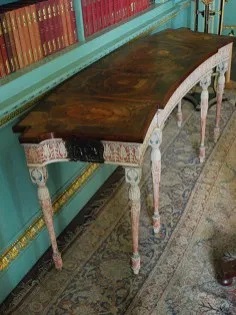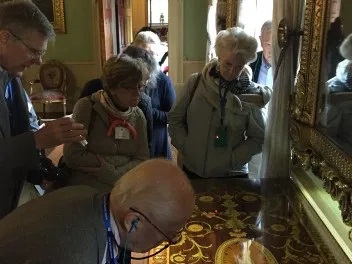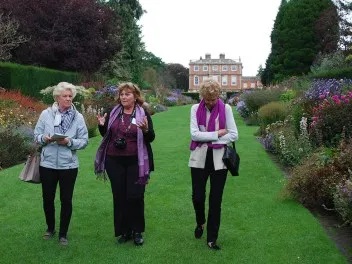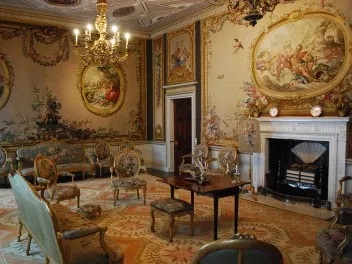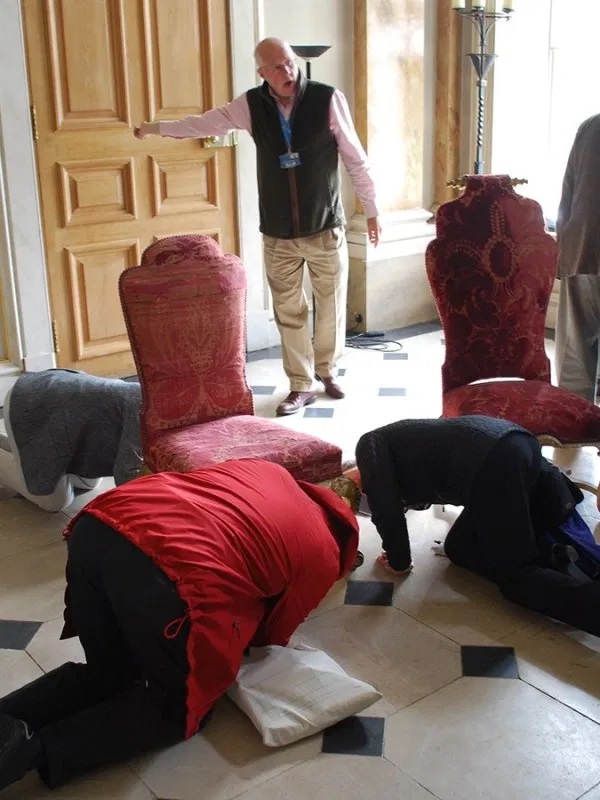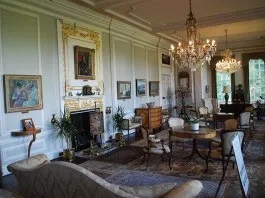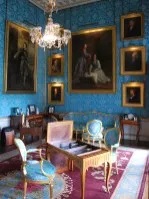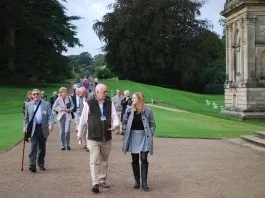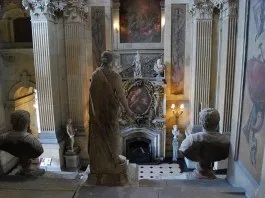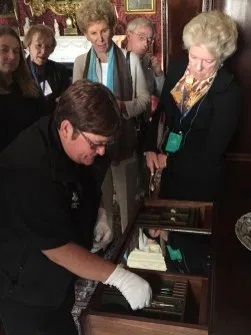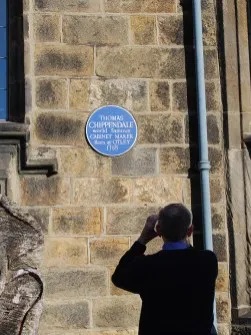A Chippendale Pilgrimage in Yorkshire
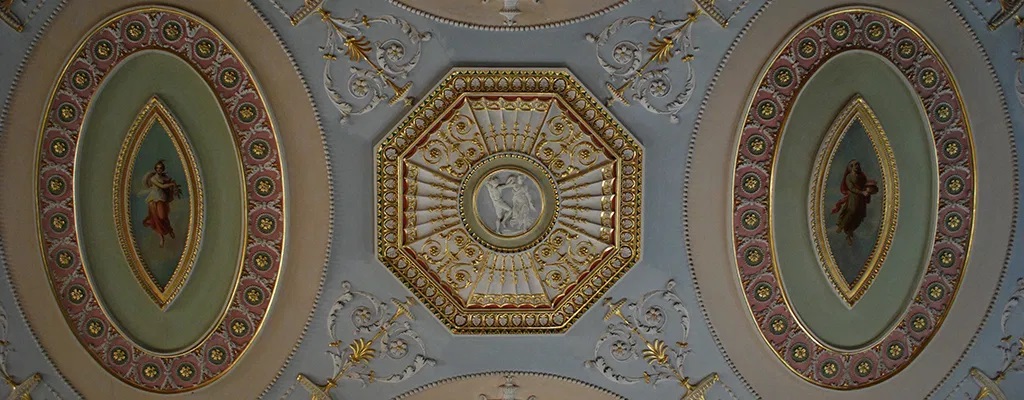
Robert Adam’s ceiling for the Gallery at Harewood House.
“Star-studded” is not usually a term we would use to describe a Trust Study Trip Abroad, but this fall’s much-anticipated trip to Yorkshire certainly fit the bill.* For the adherents to our field, figures such as tour leader and Trust Governor Brock Jobe, historians Adam Bowett and Mark Westgarth, or curators and conservators such as James Lomax and Patrick Dingwall are highly regarded and recognizable figures.
Although the tour focused on Yorkshire and the era of Thomas Chippendale, every site we encountered spoke to England’s extraordinarily long history, stretching all the way from Roman fortifications up to present efforts of preservation and presentation. Over the course of our nine-day exploration, however, we encountered more than two-thirds of the known furniture documented to Chippendale and even made a pilgrimage to the great cabinetmaker’s hometown of Otley, where he is commemorated in a full-length bronze statue. Despite seeing a record number of houses, our group could only scratch the surface of Yorkshire’s rich architectural history and collections!
The first stage of our itinerary benefitted from the expert hand of Peter Brown, former director of the York Civic Trust. Human occupation in Yorkshire reaches back into prehistory, and much of the city, including Peter’s own house, boasts surviving architecture from the Middle Ages. Long an economic and religious hub of northern England, York came into its own as a cultural center during the 18th century, resulting in elegant architecture such as the Assembly Rooms, considered England’s first neoclassical structure, and Fairfax House, an exquisite Georgian townhouse. Now a museum, the house interprets the fascinating years of the Georgian period. Appropriately for our group, Fairfax House partnered with the Decorative Arts Trust for our 2011-12 Curatorial Internship Grant, a position held by Louisa Brouwer, a Winterthur alumna who is now Keeper of Art and Place at Gainsborough’s House in Sudbury, England. During our special evening reception and tour we enjoyed the spectacular results of Louisa’s furnishing plan for the museum.
After our introduction to the era and region, we proceeded on a Grand Tour of country houses. Some of the houses–particularly Nostell Priory, Temple Newsam, and Harewood House–have developed into full-fledged museums through family trusts or associations with civic organizations such as the National Trust. Our group not only benefitted from the expertise of the professional staff at these sites, but enjoyed a level of access well beyond that of the casual tourist, with curators and collection managers opening up pieces of furniture and displaying books and manuscripts for our inspection and appreciation!
With the benefit of the combined expertise of Brock Jobe, Adam Bowett, conservator Ian Fraser, and curator James Lomax, the collection of Temple Newsam, also the seat of The Chippendale Society’s collection, proved especially memorable. Of the documented Chippendale pieces found there, one of the most exciting is an unusual dressing table with a marquetry top, originally built for the circular dressing room at Harewood House. Normally kept far behind stanchions, Adam and Ian moved the top into the window bay to allow for close inspection, while discussing the techniques behind historic marquetry and the scientific research harnessed to determine the original appearance of the piece. Thankfully, the piece will not only be conserved but also reproduced with period-accurate materials and techniques to showcase the colorful effect of Chippendale’s original marquetry design, all in time for his 300th birthday in 2018 .
Other houses we visited–such as Burton Agnes, Newby Hall, Sledmere, and Scampston–are still primarily family homes. Although open to the public on a regular basis, their role has remained as the center of working estate farms for centuries. The furnishings of these houses are still lived with on a daily basis, and while the collections may not be as intact as those of, say, a National Trust property like Nostell Priory, they still possess stellar examples of decorative arts, including pieces attributed to Chippendale. The challenge of preserving these houses and collections is that most stately homes are prohibitively expensive to run. Opening the grounds and showpiece rooms to the public goes a bit towards making ends meet. Thus, at many of these houses, we enjoyed all-too-brief excursions into their wonderful grounds and formal gardens, many of which were designed by Lancelot “Capability” Brown in the 18th century. At many properties, the grounds and gardens draw more visitors than the house itself. The estate managers and guides hope to leverage this interest in the out-of-doors by drawing guests inside by one way or another. The television and cinema industries can also provide financial assistance. Two of our sites, Castle Howard and Newby Hall, served as filming locations for the award-winning productions of Brideshead Revisited and Victoria, respectively. Perhaps not the most academic of reasons for drawing crowds, but effective nonetheless.
The attraction of exploring Yorkshire’s collections was to see how these objects continue to play a role in family life. One especially spectacular space was the Tapestry Room of Newby Hall: the most complete Chippendale interior remaining in situ in the world. As with many of his top commissions, Chippendale collaborated with Robert Adam to produce a harmonious and appealing interior, in this instance to complement a spectacular set of tapestry hangings imported from France. Thankfully, the successive generations of family residing there realized the chamber’s importance, and the space remains largely as it did in the 1760s, including a suite of French-inspired cabriole chairs with their original tapestry upholstery.
Several of the sites we visited are strictly private dwellings. For many participants, these were the most memorable, as we were welcomed by the owners themselves and offered the chance to learn about their adventures in caring for an historic home. To a person, every owner was both proud and conscious of his or her responsibility to maintain the property for the next generation, even while figuring out new ways of making the property manageable for modern life, which often includes raising a family in a very imposing structure. It was an honor to visit these private spaces and hear the introspective stories of their custodians.
This trip in particular was the experience of a lifetime, and the Trust owes a great debt of gratitude to Governor and Winterthur’s Professor of American Decorative Arts Emeritus Brock Jobe, who created the itinerary and led both tours with unfailing enthusiasm and energy. Everyone involved, from newcomers to the Trust to long-time professionals and collectors, learned much and enjoyed the benefit of Brock’s expertise as well as the insight shared by his many colleagues who participated.
* We’re are not quite sure we ought to count Christian’s unknowingly sitting next to a supermodel in a London Bar into the final celebrity talley.
About The Decorative Arts Trust Bulletin
Formerly known as the "blog,” the Bulletin features new research and scholarship, travelogues, book reviews, and museum and gallery exhibitions. The Bulletin complements The Magazine of the Decorative Arts Trust, our biannual members publication.








